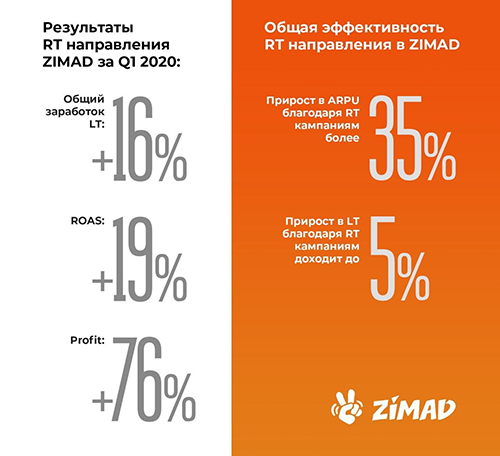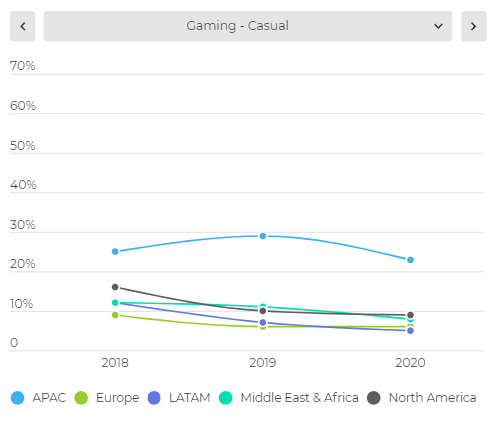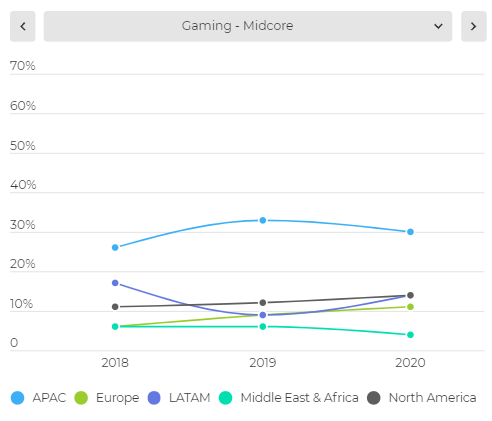What is mobile retargeting and how to use it better — in your material on App2Top.ru the marketing specialists of ZiMAD Lilia Khasainova and Kristina Borisova told.

Lilia Khasainova and Kristina Borisova
Mobile retargeting is gaining momentum. The number of applications using retargeting increased by 10% in 2019, AppsFlyer reports in The State of App Retargeting — 2020 Edition study. This suggests that mobile retargeting is becoming more popular among developers. Let’s figure out why.
What is retargeting and why is it needed?
This is an advertising tool that shows ads to an audience already familiar with the application. The main task of retargeting is to remind users about the application, motivate them to return or make a purchase.
The users targeted by retargeting are not active enough in the application (including in the monetization plan). Publishers are trying to “stir them up” with the help of advertising reminders and announcements.
But, of course, in reality everything is somewhat more complicated. For example, at ZiMAD we resort to retargeting, including to:
- encourage the user to finish the action he started (subscription, payment for a game item, much less often — incomplete registration, missed tutorial, etc.);
- increase conversion to the next purchase (for this we usually resort to special and personalized offers);
- remind the departed, but loyal user that he has not started the game for a long time;
- notify all users about new offers in the store or about new game content/features.
All together, it works both for audience retention and revenue growth.
What distinguishes retargeting from the usual purchase of users (User Acquisition)?
User Purchase (UA) is about attracting new users who may not have heard of your product yet.
For this reason, other creatives and other tools are used in the UA campaign, and the price of attraction is also, as a rule, different.
How does mobile retargeting work?
Mobile retargeting uses deep links technology. They send the user to a specific screen in the application (and already on this screen the appropriate content is waiting for him).
Such links can be “sewn” into push notifications, mailing letters, advertising banners on websites or inside mobile applications and games.
The mechanism of retargeting and deep links is best illustrated by a classic example from e-commerce: a user in an online store application looked at some product, added it to the cart, but left without buying it. After that, in various applications, the user begins to see the very product that is waiting for him in the basket. By clicking on the advertisement, the online store application opens, and if the deep link was configured correctly, then not just the main screen will open, but a basket with the left product.
In mobile games, retargeting is primarily focused on those who have not logged in or paid for a long time. If, when analyzing the segments of the project, the marketer sees that some part of the audience has decreased activity, then he launches a campaign during which, for example, on Facebook pages, former users see information about new features of a familiar game or news about a sale. In this case, the deep link will direct the user to a screen with information about the game event or to a store where the products for the promotion will be highlighted in some way.
But retargeting is also resorted to in other scenarios (not only with low activity). It all depends on which segment of users we are talking about.
User segmentation and retargeting scenarios
First of all, users are divided into paying and non-paying. Already within these segments there are additional divisions (including by activity):
- non-paying users are segmented by business metrics, as well as by progress (whether they have opened the game, completed training, passed the first level, and so on), activity (how often they enter the game, how much time they spend, etc.), by how long they have been involved in the game;
- the paying audience is further segmented by how much, how often and when it pays.
Depending on the task, different segments are selected for retargeting. For example:
- if you want to increase retention, then you should tell the whole audience about new gaming events;
- if you need to increase the number of payments, it is better to notify the “minnows” about a generous sale;
- it is necessary to increase the DAU — it would be good to let non-paying players know about a big gift.
Please note that retargeting campaigns should not focus exclusively on users who are already paying, whose share of the entire audience is rarely more than 1-3%. With its help, it makes sense to increase the share of the paying audience in the first place. This is where he is particularly effective.
How is retargeting related to the number of paying users?
Retargeting directly correlates with the number of paying users. This aspect is discussed in detail in the above-mentioned The State of App Retargeting – 2020 Edition from AppsFlyer. Applications that use retargeting have a higher proportion of paying users than those where this attraction tool is not used.
This is completely consistent with our own observations. Less than a year ago, we started retargeting. It already accounts for 10% of all our advertising campaigns. And we are very pleased with our experiments in this direction.
According to the results of the first quarter of 2020, the share of paying users among the audience attracted by retargeting is twice as large as with UA purchases.
In addition, we have:
- the cost of attracting with retargeting is 70% lower than with UA;
- retargeting campaigns on average pay off twice as well compared to UA.
There are a few more numbers on the infographic just below:

However, our experience today is limited to a library of products in the puzzle genre. In other directions, retargeting may not be as effective.
Does retargeting work for all gaming niches?
The same AppsFlyer study can answer this question. It shows the average conversion of retargeting ads to the launch of the application by genre verticals.
For example, in casual games in most regions, the conversion rate is small and it decreases:

In midcore games, the trend depends on the region. In Europe, the conversion rate is steadily growing:

Also, the effectiveness of retargeting in hardcore games strongly depends on the regional binding. If the situation is stable in North America, then it is falling in others:

It’s a completely different story with social casinos, where there is now an increase in conversion with retargeting in most regions:

These graphs clearly show that the effectiveness of retargeting depends on both the niche and the region.
In the Western world, as we saw just above, retargeting shows itself worst in casual products. This can be explained by the high popularity of hypercausal products, which are distinguished by a short Lifetime (LT). These are very simple games, without additional mechanics and with advertising monetization. Retargeting is less effective for them.
A completely different story with hardcore and midcore games, which are characterized by:
- a large loyal community with which retargeting can work effectively;
- a long LT that allows you to track the peaks and troughs of user interest in the project;
- comprehensive monetization that provides great options for special promotions;
- high solvency of the audience.
The last two points are also relevant for games in the genre of social casino. Along with addictive mechanics, this gives a conversion rate above 20% in the niche as a whole. It seems to us that this is an excellent result.
How to prepare a retargeting campaign?
Before launching a retargeting campaign, you should:
- Thoroughly test deep links. They should work flawlessly.
- Segment the audience. A marketer should know who to work with and who should be excluded from coverage.
- Prepare a large pool of promotional materials. Creatives should be personalized for the offers that are offered in advertising.
- Select an advertising partner through which retargeting will be launched. It is better to go to the leaders in this niche. It is better not to attract unknown people, because there is a risk that they can sell your list of high-quality users to someone. Leaders can be easily found using mobile analytics systems like Appsflyer and Singular. They publish the ranking indexes of advertising networks, according to which there are good advertising partners.
- Build analytics that will allow you to calculate the effectiveness of the retargeting campaign (important: it will be necessary to track not only the ROI of the campaign, but also its impact on all business metrics by segment).
Should we be afraid of retargeting reduction in connection with the imminent release of iOS 14?
The other day it became known that with the release of iOS 14, users will be able to block the transfer of information about themselves to advertising companies by clicking (that is, block IDFA, which allows retargeting). For many, this caused concern: whether this will be the end of retargeting on the Apple platform.
It seems premature for us at ZiMAD to talk about this. Retargeting is a huge part of marketing, where a lot of money is poured in. Even if significant changes are waiting for it, then most likely Apple will offer or be ready to develop alternative re-engagement tools.
***
Now we are continuing to work with retargeting. And we will be happy to answer all your questions about this in the comments under the material or on social networks.
